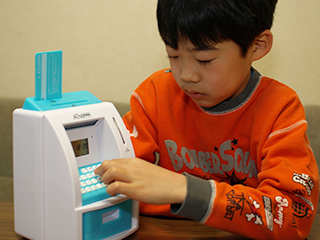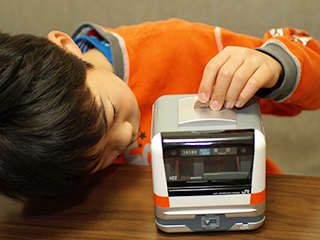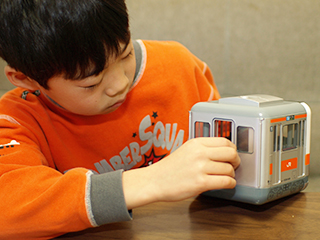
Saving money is fun with this train-shaped money box, which plays a melody when a coin is dropped in. © targa
Have you ever used a money box, which you might also know as a piggy bank? If you were in Japan, you would have seen a succession of various money boxes. For example, with one type, you need to enter a password to take money out. Another type plays sounds when you put in a coin. Japanese money boxes make saving fun.
The Roots of Japanese Money Boxes: Are They More Than 2,000 Years Old?!

Senbei tsubo that was a money box in the Muromachi Period. The brown earthenware jar has a large mouth and slightly bulging shape. © Amagasaki Shinkin Bank - The World Money Box Museum
Did early people also use money boxes as we do? Around the world, money boxes have been used for thousands of years, and the reason for their introduction seems to vary from country to country. In Europe and the United States, for example, donation boxes are said to be the ancestors of money boxes. In Japan, money boxes may have been developed from the earthenware jars for storing rice grain or water, according to researchers. The earliest examples appeared at the end of the Jomon Period, which lasted from about 3100 to 400 BCE. At the time, the cultivation of rice plants started to produce rice grain in Japan, and people stored harvested rice grain in earthenware jars. Later, in the Muromachi Period, which ran from 1336 to 1573, people developed the habit of saving money in brown round earthenware jars called "senbei tsubo." Isn't it interesting that the history of money boxes is different in each country, even though all money boxes are in essence the same?
In Japan as in many other countries, people have used money boxes with motifs considered lucky. Standard money boxes are in the shape of Maneki Neko, a beckoning cat that symbolizes the bringing of good luck and wealth. Others are shaped like, for example, the long-familiar god of business prosperity whom the Japanese people call "Ebisu-sama."

Examples of money boxes with motifs of longstanding symbols of good luck in Japan © Amagasaki Shinkin Bank - The World Money Box Museum
Interesting Money Boxes Make It Fun to Drop a Coin
Let's take a look at the latest trends in Japanese money boxes. A popular trend among children is money boxes that have features like toys. For example, children enjoy playing with objects that look similar to what their parents use, and one money box looks very much like a bank automated teller machine, or ATM. People use an ATM to deposit or withdraw money in a bank or post office account. The machines are installed in financial institutions, supermarkets, convenience stores, and other locations so that people can access their money at any time. And like in the case of an ATM, to take money out of this money box, a child inserts a card and punches in a PIN code just as a parent would do. It's exciting to put in money and take out money when different sounds come out in response. What's more, the screen displays the total amount saved so far, giving the child a feeling of satisfaction about what she or he has accomplished. This mechanism encourages children to continue saving.

Children insert a card (left) and money (right). The money box responds with delightful sounds, making it fun to handle. © Peanuts club Co., Ltd.

Just like at a real ATM, children need to enter a PIN code to take out money, so they feel like adults. © Peanuts club Co., Ltd.
There is also a train-shaped money box that looks much like the real thing. When a coin is inserted, the headlights on the train go on, followed by the short melody of eki-melo. Eki-melo refers to the melody played at an actual train station to inform everyone that a train is departing. One characteristic of the played melody is that it varies depending on the station or railway company. The money box plays six different melodies. Since children do not know which eki-melo is played until they drop a coin in it, they may feel the thrill of anticipation as they insert a coin, wondering which melody will play this time. In Japan, many adults are train enthusiasts. They too love the train-shaped money boxes.

From a train window, the boy can see the coin dropping. Peering inside, he may be wondering, "How much have I saved?" © targa

Not there for decoration, the rear door of the train can open. Money can be taken out from the door. © targa
Make Your Own Original Money Box!
Recently, children are eager to have their own original money boxes. An increasing number of children are creating money boxes from scratch with cardboard, clay and a milk carton. There are also many money boxes made by children and handed in as their homework for summer vacation. They make animal, car, house and other kinds of money boxes, each a unique creation that is rich with ideas.
Some children, however, may hesitate because they think that it will be difficult to create a money box from scratch. But they don't have to worry about it! In Japan, a money box can be easily assembled from a kit sold in stores. For example, a child can create a money box from one kit in about 30 minutes without using tools such as a saw and nails. Some kits are popular because the actions of a rabbit or cat make children laugh. The eyes, hands and ears of the animal move about comically and repeatedly when a coin is in place and the handle at the front is turned. Before long, the coin will drop into the box with an audible clunk sound as it hits the bottom. Children get absorbed in the kits, which give them a chance to experience the excitement of doing crafts, the sense of accomplishment afterward and the fun of discovering how it all works.

With diligent effort, these two children made their money boxes as they carefully read the instructions. They felt very happy when they were done. They even felt encouraged to say, "We're going to save a lot of money from now on." © EYE STUDIO WOODS
Japanese money boxes are unique and full of playful features. Saving is more fun with a favorite money box like this. How are they different from the money boxes in your country?
Related ArticlesMONTHLY NEWS